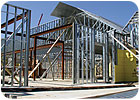

The story Don wrote began by saying, “A new dimension has been added to the operating scope of many wall and ceiling contractors. Load-bearing steel stud and joist framing is opening new horizons.”
Don also wrote, “One of the first applications (of load-bearing) was an experimental residential project done in 1941 by the Milcor Steel Company.” However, World War II created restrictions against the use of steel for residential purposes. “In the 1950s and early 1960s there were scattered projects, but no significant volume of load-bearing work and very few contractors involved. In the mid 1960s, one of the first office buildings with bearing steel stud support was constructed. Numerous Navy Bachelors Enlisted Quarters projects were also released for construction in the late 1960s. Since then, the system’s acceptance has grown slowly but steadily.”
In the early 1980s I was invited by Milcor-Inryco Steel to attend a load-bearing and spandrel panel weeklong training seminar in Wisconsin. In total there were about 10 wall and ceiling contractors throughout the United States who were invited, and none of the attending companies were in competition with one another. Inryco invited us based on the fact that each of our companies was doing the greatest amount of load-bearing/spandrel panel work in each geographical location as compared to our competitors. The classes were intense and ran 10 to 12 hours per day and included homework.
Who Knows
Inryco put a lot of time and money into its training program and the knowledge gained by the attendees was substantial. After the training, many of the attending companies decided to grow their load-bearing and spandrel panel businesses. Looking back, I see it as somewhat of a perfect storm in that interest rates were climbing, the economy was beginning to struggle, but the commercial market overall was doing relatively well.Besides having a struggling economy, no one really researched whether there would be widespread acceptance of load-bearing and spandrel panel construction. Rather than finding a need and filling it, the industry tried to sell pre-fabricated metal stud construction.
Since the 1980s and into the late 1990s many contractors considered pre-fabricated load-bearing panels as the wave of the future, however, many contractors have gone broke relying on a product line that is uncontrolled. What I mean by “uncontrolled” is that almost anyone is allowed to install it.
If someone wants to jump into the load-bearing business there are plenty of manufacturers who will sell them the steel they need. There are also GCs who are guilty of getting wall and ceiling contractors into the load-bearing business as a way to help their budget problems.
American businesses have the option of doing whatever they want in terms of deciding what their business plan includes, and this is one of the reasons why a company like Inryco wanted to be in front of the load-bearing manufacturing business curve.
The software company Microsoft was absolutely in front of the software curve for the masses when it started. Since Microsoft’s beginning, software companies have come out of the woodwork and I’m sure these new companies have impacted software giants like Microsoft. It’s called dilution of a market.
A limited market
Another huge market factor is the fact that load-bearing panels are not purchased by the masses. The market for load-bearing work is somewhat limited. The market becomes more and more limited as new competitors jump in. As an example, when one new restaurant opens in your town the impact to the existing restaurants is felt. When several new restaurants open, the impact to the existing restaurants is severe. In other words, wall and ceiling contractors considering getting into this segment of the industry have to know how much load-bearing business is available and divide that by the number of competitors. We also have to consider how many new load-bearing competitors will spring up in the future.I have a theory that may or may not be true, but I believe it has merit for consideration. The theory goes something like this, “if you know how much it costs to stick-frame load-bearing walls; how much more or less will it cost you to prefabricate, ship and then install?” I’ve often wondered why so many people think building panels in a warehouse and shipping them to a job would cost less than building the walls in place. In my opinion it should cost more to prefabricate, unless you’re selling to the masses.
I don’t know of any panel shops that are selling to the masses. We are seeing panel shops who sell pre-fabricated load-bearing panels to wall and ceiling contractors who in turn install the panels. Do these shops buy their material cheaper than we do?
Maybe their labor costs are much lower than ours? In the end, how much cheaper is it for us to prefabricate load-bearing panels? An argument in favor of load-bearing is the speed factor. You can prefab panels in advance of needing them and you can install the panels faster than you can install stick-frame if the panels are fabricated correctly. The selling point then becomes speed.
If prefabricated load-bearing panels allow buildings to be built faster where is all the savings being spent? I’m not aware of any studies wherein it has been determined that faster is less expensive. Although the load-bearing panel portion of a project may be installed faster than stick framed; does that mean the overall project is completed faster?
What's the Fuss?
If I let my imagination run wild and allow myself to think only of opportunities in the panel business, I’m sure I could convince myself and others that it’s the best thing since sliced bread. The following are just a few of the major issues to consider when discussing the load-bearing business:• Anyone can get into the business.
• Faster and overall less expensive.
• Substantial risk in building/designing the structure.
• Inherent up front costs.
• Plant or fabrication facility.
• Logistics.
• Ongoing overhead.
Trying to determine the profitability of a state-of-the-art fabrication plant for panels is difficult unless you know you can keep the facility busy 24 hours a day, five days per week. If you can’t keep it busy, you’re going to lose money. Ford and GM build cars for the masses and it’s become obvious that they are having trouble competing no matter how automated they become. If you don’t have a large enough market you can’t mass produce cars or panels. The number of car manufacturers continues to increase as well as their market share, which further dilutes the market for companies like Ford and GM.
Dilution of the load-bearing market is far easier to do because it takes a lot less money to do it. Auto manufacturers need billions of dollars to create a new facility and they know in advance that they can produce an equal or better car at a cheaper price.
Can wall and ceiling contractors produce load-bearing panels at equal or better quality and price than its stick-built counterpart?
Competition
Most of my reasons for writing about load-bearing panels have more to do with the limited market and the number of uncontrolled competitors who get into the business and either fail or get out, and the fact that manufacturers of steel-framing materials are also in the business.It’s easy to look at the load-bearing market from a positive perspective because manufacturing appeals to us. Manufacturing hundreds, thousands, or millions of panels in a huge warehouse allows us to control costs better than we can on a jobsite. There are many positives to consider in the manufacturing business and as they say, “the grass is always greener on the other side of the fence.”
Keep in mind that steel manufacturers are trying to find new ways to sell steel and they will promote load-bearing as long as it’s a viable market. One way to make it a viable market is to sell to anyone who wants to get into the load-bearing business, including selling to a manufacturer’s subsidiary.
A company’s stock can be “diluted” which is the same as being made weaker by issuing more stock. The same applies to a market where you have only so many jobs with too much competition. The load-bearing market at some point will be diluted due to economic or market conditions. Manufacturing only one thing can be a risky business.
Manufacturing is an interesting business, yet, I wonder why manufacturers in a variety of industries are getting closer and closer to going direct to the customer. I think we have to consider the possibilities.
Inryco’s Don Schroeder believed in the load-bearing market and wanted to make sure that those in the load-bearing business were qualified to perform the work. Local Seattle contractors also remember Pete Peters, the local representative for Inryco Steel, who also had the same goals as Don Schroeder. These were some of the great men of our industry–they promoted the contractor.
Remember: Teamwork begins with a fair contract.




Report Abusive Comment